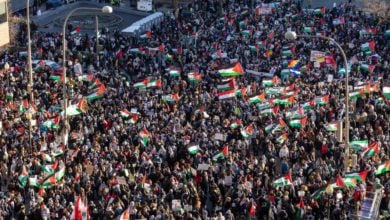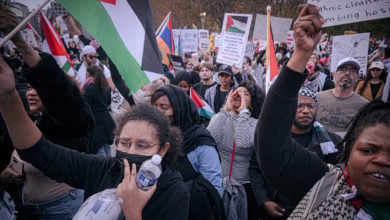
The whole world watched the U.S. government rush munitions, its most advanced aircraft carriers and the most advanced fighter jets to Israel so it could wage a genocidal war on the two million Palestinians trapped in Gaza.
This is not just an Israeli war, it is a U.S.-Israeli war. Washington is also a perpetrator of genocide. It is fully and equally responsible for every death, every maiming and all suffering made possible by the bombs that it supplies and that Israel drops.
Despite the verbiage to justify this intervention, Washington is not motivated by humanitarian concerns for Jewish lives. The U.S. government is propping up the most important proxy force that it has to maintain its control of the Middle East after that proxy’s weakness were exposed by the ongoing heroic Palestinian uprising.
$260 billion in U.S. aid
Israel is a tiny country whose population is roughly equal to that of New York City. Some nine million live within the Israeli green line — seven million Jews, two million Palestinians — yet it is the biggest recipient of U.S. aid in the world since World War ll. In that time, Israel has received more than $260 billion, mostly in military aid, plus $10 billion more for missile defense systems like the Iron Dome, which the Palestinian uprising was able to circumvent.
This money is not for development. It is to wage war on progressive governments and liberation struggles in the region, especially the Palestinians. Israel is a strategic outpost of Western and especially U.S. imperialism and has been from its creation. It is crucial to Washington’s empire. The giant Pentagon buildup with its more than 700 bases worldwide, was largely built upon the control of Middle Eastern oil which Israel helps it maintain. This is why Democratic and Republican administrations may disagree on many things, but never on support for Israel.
What is the history?
Palestine was at the center of what the West calls the Middle East, the bridgeway between the continents of Africa, Asia and Europe, and one of the most oil-rich areas of the world.
This fact was not lost on Washington when it emerged from World War ll as the new world power. In 1944 a U.S. State Department memo refers to Middle Eastern oil as “a stupendous source of strategic power, and one of the greatest material prizes in world history.”
It was to grab this prize that, in November 1947, the U.S. helped push through the UN resolution partitioning Palestine into a Zionist state and an Arab one, giving the Zionist authorities control of 54% of the land when the Jewish settlers were a third of the population.
For the same reason, in 1948, when Zionists seized 77% of Palestine through massacres such as Deir Yassin and expelling some 700,000 people from their homes, the U.S. was the first government to give it diplomatic recognition.
Imperialist motivation for populating Israel with refugees from the Holocaust in Europe was not to provide a safe haven for Jewish people, but to use them to populate an imperialist outpost and to pit them against the indigenous population when needed. Israel’s Zionist founders agreed to this arrangement. As early as 1951, only three years after the formation of Israel, Prime Minister David Ben Gurion stated:
“Strengthening Israel helps the Western powers to maintain equilibrium and stability in the Middle East. Israel is to become the watchdog. There is no fear that Israel will undertake any aggressive policy towards that Arab states when this would explicitly contradict the wishes of the U.S. and Britain. But if for any reason the Western powers should sometimes prefer to close their eyes, Israel could be relied upon to punish one or several neighboring states whose discourtesy towards the West went beyond the bounds of the permissible.” (Ha’aretz, Sept. 30 1951).
The death of every Palestinian and every Jewish person to date in the so-called “Israeli-Arab conflict” is due to this fundamental arrangement of the establishment of Israel first and foremost as a watchdog for imperialism, with U.S. imperialism and their Zionist clients fully responsible.
In the late 1950s and 1960s, a wave of anti-colonialism swept the Middle East. Egyptian troops fought alongside their Yemeni brothers and sisters against Britain. Syria and Egypt took steps toward a merger, reflecting the revolutionary yearning of the Arab people to unite against imperialism. The then-progressive governments in Syria and Egypt merged, and in 1966, the Syrian government announced plans to nationalize Taplin, the oil pipeline owned by U.S. companies that ran through it.
By the 1960s, Wall Street was making billions in profits from Arab oil, and 60% of that oil fueled the Pentagon’s war against the people of Vietnam. Washington did not like the prospect that the people of the region might take back their resources.
In 1958, Washington sent the marines to Lebanon to prevent a peoples’ movement from gaining power. Washington did not want to send in U.S. troops again. It wanted to be free for conquests elsewhere, like in Vietnam. It wanted a proxy force to do the fighting for the oil companies in the Middle East.
In June 1967, Israel launched the so-called “Six Day War,” an attack on Egypt, Syria and Jordan. Like today, the Israelis were armed by the Pentagon with sophisticated weapons including napalm, the 1960s equivalent of white phosphorous, which was used extensively. The war ended with Israel occupying Syria’s Golan Heights, Egypt’s Sinai Peninsula and the West Bank and Gaza Strip, parts of historic Palestine.
After that war, the U.S. State Department wrote in a memo, “Israel has probably done more for the U.S. in the Middle East in relation to money and effort invested than any of us so-called allies and friends elsewhere around the world since the end of the second world war. In the Far East, we can get almost nobody to help in Vietnam. Here the Israelis won the war singlehandedly, have taken us off the hook, and have served our interest as well as theirs.” (U.S. News and World Report, June 19, 1967.)
Israel continues to play this role today.
A hit man for the U.S. in Latin America, Asia
The U.S. relies on Israel not just to quell liberation struggles in the Middle East. It made Israel a junior partner in its military-industrial complex so it could export arms and train some of the most reactionary and murderous forces in the world. It offers what the Pentagon “practical assistance,” where the U.S. doesn’t want to be as involved and getting its hands dirty.
Israel has armed reactionary regimes in Myanmar, Rwanda, South Sudan, Haiti, and always had close ties to apartheid South Africa.
The list of reactionary forces and governments Israel has supplied, trained and advised in what Washington patronizingly considers its “backyard,” includes Argentina, Bolivia, Brazil, Colombia, Costa Rica, Dominican Republic, Ecuador, El Salvador, Guatemala, Haiti, Honduras, Nicaragua, Panama, Paraguay, Peru and Venezuela. (Al Jazeera)
But it isn’t only the sale of planes, guns and weapons systems that characterizes the Israeli presence in Latin America.
Israel excels in advising, training and running intelligence and counter-insurgency operations in Latin America’s most bloody and brutal conflicts in Argentina, El Salvador, Guatemala, Nicaragua and Colombia.
It trained and armed the ultra-reactionary Salvadorian army in the 1980s against a liberation struggle there, supported the anti-semitic Argentine military government of the late 1970s and early 1980s when that government was involved in a war of death squads and disappearances. All this was to benefit Wall Street.
Israel armed and trained Nicaragua’s hated Somoza dictatorship which was eventually overturned by a popular uprising in 1978. The Israelis and the U.S. had been supplying Somoza with weapons for years. But when President Jimmy Carter came into office in 1976, he ordered a cessation of all U.S. military assistance to Nicaragua. So, Israel immediately increased its weapons supplies to Somoza until he fled the country when the Sandinistas took power.
What is Israel really? Alexander Haig, U.S. Secretary of State from 1981-82, put it succinctly when he said “Israel is the largest American aircraft carrier in the world that cannot be sunk, does not carry even one American soldier, and is located in a critical region for American national security.”
Scuttling a two-state solution
The Oslo Accords, signed by Israel and the Palestine Liberation Organization in 1993 at the While House, though controversial among Palestinians, offered some the hope of a Palestinian state. But Israel immediately violated the agreement through steady theft of West Bank land, the establishment of hundreds of checkpoints limiting Palestinian movement there, and by repeatedly bombing Gaza and besieging it for 17 years, and a great many other violations.
Thousands of pages have been written about Israeli human rights abuses in this period. The U.S. was never interested in a truly independent Palestinian state because it would be a challenge to imperialism. Washington looked the other way or blamed the Palestinians for resisting Israeli oppression. The U.S. even provided a cover for Israeli oppression. Since 1972 Washington has cast a veto in the UN Security 53 times to block resolutions critical of Israeli actions. This blanket support encouraged more Israeli aggression.
Palestinian resistance exposes Israel’s vulnerability
The U.S. has long given Israel the most sophisticated weapons in its arsenal and thought it invincible. But the Palestinian rebellion’s penetration of the U.S.-supplied high tech Israeli defenses has exposed the fundamental vulnerability of this settler state. Weapons alone cannot stop a Palestinian population determined to win its freedom.
With the U.S. openly rushing to a weakened Israel’s aid, the resistance has also laid bare the fact that the U.S. is not an impartial arbitrator in the Middle East struggle, as it likes to claim. Israel is a U.S. creation, designed to serve U.S. interests and kept afloat by U.S. tax dollars.






